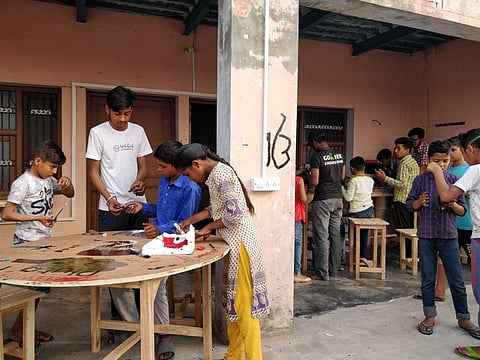

Banjarapalya is a village that is 15 kilometres away from Bengaluru. Despite being that close to the country's IT capital, most of the people had no idea about the advancements of technology. Four years ago, smartphones and computers were completely alien to them. I use past tense here because now, that is history. Today, the villagers are self-taught researchers who are quite tech savvy and computers provide solutions to most of their problems. So, what happened in a span of four years? An engineer moved there after quitting his IT job and began a zero budget project in the hope of teaching the villagers about technology by setting up Nooks. His name is Abhijit Sinha and his initiative Project DEFY is doing wonders, helping youngsters improve the quality of their lives.
On a busy day, we caught up with Abhijit to listen to his incredible story of revolutionising technology and he, of course, had a lot to share. Excerpts:
How did the idea of creating Nooks come up?
In 2014, I moved to Banjarapalya and started experimenting with how individuals respond when simply given access to smartphones at first and then, computers and the internet. We saw that, unlike popular belief that training is required to use computers, the children in the village were able to use them even the first time without any instruction. It only took some trust and letting them be.
We began in a small room with a few laptops and a good internet connection. With YouTube tutorials, we started building small projects out of the everyday trash and the few tools we had. In a few months, we had around 60 daily users of the space coming in at their own timings and building things of their own interest, with almost no help from me other than holding the door open.
My final experiment was to leave the space on the hands of the villagers and see if it would function without me, with only a promise that I would take care of the rent and bills. I returned after three months, expecting a defunct space, but to my surprise that wasn’t true. There were more people than ever, more projects than ever and even more equipment than before contributed by the community.
How difficult was it to implement the idea?
We had absolutely no money. However, the lack of resources turned out positively for us as we learned what can be salvaged from trash and how much can be reused. We continue to use trash as a significant source of building and learning material. There were many other challenges from time to time, including the local school disliking us as the children enjoyed their time at the Nook far more than at school. We overcame one challenge at a time, always seeking help from friends and well-wishers.
How did you get the villagers to learn computers?
We never tried to 'teach' computers. Instead, we leave people to play with computers by themselves and let them ask for help if they get stuck. When creating a new Nook, we follow a three-step policy if one is trying to figure out or learn something — ask a friend, ask Google, and if both of these don’t have an answer, then ask me. We noticed that the basic operation of the computer is not difficult to figure out and learners usually help each other through it. We complement this first engagement with our space and an induction programme, where we expose them to several internet resources which help in learning and building, along with utilitarian resources like YouTube, Google Drive, Google Docs, Translate and so on, to help with the experience. However, we don’t have a course on computer training.
How do you ensure that time is spent on fruitful projects?
The very definition of what is a 'fruitful' expenditure of time is defined by the learners and the community. The learners come to the Nook for various reasons. Some come here to gain new skills for a job, some to create an enterprise, some just for fun. Many come and don’t know yet what they can or want to accomplish there. In a way, it is an undefined space where each person is allowed to create their own outcomes and meaning.
Two years down the line, are there any major achievements that you'd like to recall?
In the early days, every little project we made was a great achievement. Every toy boat that didn’t sink, every plant we grew that didn’t die and every girl who came through the door, challenging the patriarchy of her society, was a win. In the deepest sense, they still are our greatest achievements. In the last two years, we've grown from 1 space to now a total of 12 across India and also a refugee camp in Uganda. We have worked with diverse communities and created Nooks together with them.
Why is it called Project DEFY?
Sometime back, when I was not entirely sure of what I was doing after I had already created the first Nook, someone asked me how I would define education. I had no answer for that. I said that I could only talk about what education I want and what I expect out of it. But each individual has different needs and interests, and therefore, it would be unfair to create one definition for everyone, for the various contexts of the world. We named it Project DEFY because 'defy' means to challenge the status quo, which in this case is the 200-year-old educational format that we continue to use in this country. DEFY also stands for Design Education For Yourself, for each person must create for themselves what education will be for them and what they should expect from it.
